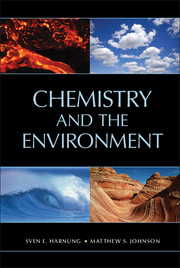Book contents
- Frontmatter
- Contents
- Preface
- Acknowledgments
- Chemistry and the Environment
- Introduction
- 1 The Earth
- 2 Environmental dynamics
- 3 The Spheres
- 4 Chemistry of the atmosphere
- 5 Chemistry of the hydrosphere
- 6 Chemistry of the pedosphere
- 7 Global cycles of the elements
- 8 The chemicals industry
- 9 Environmental impact of selected chemicals
- 10 The chemistry of climate change
- Appendix 1
- Appendix 2
- Appendix 3
- Appendix 4
- Appendix 5
- References
- Name index
- Subject index
- Miscellaneous Endmatter
Preface
Published online by Cambridge University Press: 05 November 2012
- Frontmatter
- Contents
- Preface
- Acknowledgments
- Chemistry and the Environment
- Introduction
- 1 The Earth
- 2 Environmental dynamics
- 3 The Spheres
- 4 Chemistry of the atmosphere
- 5 Chemistry of the hydrosphere
- 6 Chemistry of the pedosphere
- 7 Global cycles of the elements
- 8 The chemicals industry
- 9 Environmental impact of selected chemicals
- 10 The chemistry of climate change
- Appendix 1
- Appendix 2
- Appendix 3
- Appendix 4
- Appendix 5
- References
- Name index
- Subject index
- Miscellaneous Endmatter
Summary
Chemical species made by humans affect many naturally occurring processes and organisms. The observation of an anthropogenic substance in Nature raises a series of questions: Where did it come from? How and why was it produced and released? How does it move around within the environment? What is its chemistry, including the reaction rate, mechanism, and products, and how does it influence living organisms and the .EnvironmentalEarth system? More generally, and perhaps not within the focus of scientific chemistry, there are questions such as: Who is entitled to make use of Nature and to what extent? Are there limits to growth? A rational discussion of these questions involves the scientific method and results from the physical sciences, as well as law, economy, and the humanities.
Turning to chemistry: there is no doubt that success in the field of environmental chemistry requires mastering fundamental disciplines such as analytical chemistry, thermodynamics, and modern experimental and theoretical chemistry. The important role of environmental chemistry as a field in its own right is recognized internationally: the International Union of Pure and Applied Chemistry, IUPAC, has organized scientific investigations of the environmental impact of chemistry for many years; examples include its series of reports on pesticides, starting long before environmental issues were of political and public interest, and the White Book on chlorine. Recognition of the importance of the subject has driven IUPAC to rename its Applied Chemistry Division the Chemistry and the Environment Division. The significance of this change is underlined by the fact that the word Applied is part of the very name of the Union.
- Type
- Chapter
- Information
- Chemistry and the Environment , pp. xi - xiiPublisher: Cambridge University PressPrint publication year: 2012

